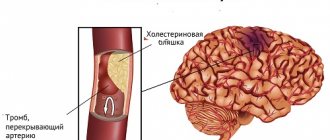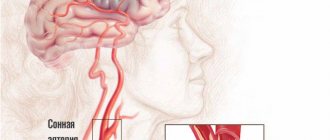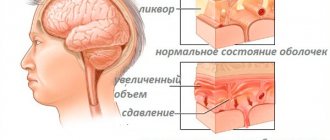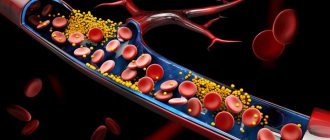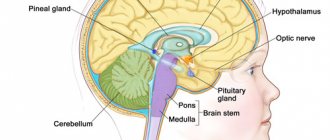Demyelinating diseases constitute a large group of neurological pathologies. Diagnosis and treatment of these diseases are quite complex, but the results of numerous studies by scientists allow us to move forward in the direction of increasing efficiency. Advances have been made in early diagnostic methods, and modern treatment regimens and methods give hope for prolongation of life and for full or partial recovery.
Causes and mechanisms of demyelination
In the human body, the nervous system is formed of two sections - central (brain and spinal cord) and peripheral (numerous nerve branches and nodes). A well-functioning regulatory mechanism works in this way: the impulse generated in the receptors of the peripheral system under the influence of external factors is transmitted to the nerve centers of the spinal cord, from where they are sent to the nerve centers of the brain. The control impulse, after processing the signal in the brain, is sent along a descending line again to the spinal cord, from where it is distributed to the working organs.
The normal functioning of the entire body largely depends on the speed and quality of transmission of electrical signals along nerve fibers, both in the ascending and descending directions. To provide electrical insulation, the axons of most neurons are covered with a lipid-protein myelin sheath. It is formed by glial cells, and in the peripheral part - from Schwann cells, and in the central nervous system - from oligodendrocytes.
In addition to its electrical insulating functions, the myelin sheath provides an increased speed of impulse transmission due to the presence of nodes of Ranvier in it for the circulation of ionic current. Ultimately, the speed of signal transmission in myelinated fibers increases 7-9 times.
What is the demyelinating process?
Under the influence of a number of factors, the process of destruction of myelin, which is called demyelination, can begin. As a result of damage to the protective sheath, nerve fibers are exposed, and the speed of signal transmission slows down. As the pathology develops, the nerves themselves begin to deteriorate, which leads to a complete loss of transmission capacity. If at the onset of the disease it is possible to treat and restore myelination of axons, then at an advanced stage an irreversible defect is formed, although some modern techniques make it possible to argue with this opinion.
The etiological mechanism of demyelination is associated with abnormalities in the functioning of the autoimmune system. At a certain point, it begins to perceive the myelin protein as foreign, producing antibodies to it. Breaking through the blood-brain barrier, they generate an inflammatory process in the myelin sheath, which leads to its destruction.
In the etiology of the process, there are 2 main directions:
- Myelinoclasty is a disorder of the autoimmune system that occurs under the influence of exogenous factors. Myelin is destroyed due to the activity of the corresponding antibodies that appear in the blood.
- Myelinopathy is a disorder of myelin production that occurs at the genetic level. Does a congenital anomaly in the biochemical structure of a substance lead to its perception as a pathogenic element? and causes an active immune system response.
The following reasons are identified that can trigger the process of demyelination:
- Damage to the immune system, which can be caused by bacterial and viral infections (herpes, cytomegalovirus, Epstein-Barr virus, rubella), excessive psychological stress and severe stress, intoxication of the body, chemical poisoning, environmental factors, and poor nutrition.
- Neuroinfection. Some pathogenic microorganisms (usually of a viral nature), penetrating the myelin, cause the myelin proteins themselves to become a target of the immune system.
- A metabolic disorder that can disrupt the structure of myelin. This phenomenon is caused by diabetes mellitus and thyroid pathologies.
- Paraneoplastic disorders. They occur as a result of the development of oncological tumors.
REFERENCE! Particular attention should be paid to the mechanism of demyelination associated with infectious lesions. Normally, the immune system's response is aimed at suppressing only pathogenic organisms. However, some of them have a high degree of similarity to the myelin protein, and the autoimmune system confuses them, starting to fight its own cells, destroying the myelin sheath.
Types of demyelinating diseases
Taking into account the structuring of the human nervous system, 2 types of pathologies under consideration are distinguished:
- Demyelinating disease of the central nervous system . Such diseases have an ICD 10 code from G35 to G37. They include damage to the organs of the central nervous system, i.e. brain and spinal cord. Pathology of this type causes the manifestation of almost all variants of neurological type symptoms. Its identification is made difficult by the absence of any dominant symptom, resulting in a blurred clinical picture. The etiological mechanism is most often based on the principles of myelinoclasty, and the lesion is diffuse in nature with the formation of multiple lesions. At the same time, the development of the zones is slow, which causes a gradual increase in symptoms. The most typical example is multiple sclerosis.
- Demyelinating disease of the peripheral system. This type of pathology develops when nerve processes and nodes are damaged. Most often they are associated with problems of the spine, and progression of the disease is observed when fibers are pinched by the vertebrae (especially with an intervertebral hernia). When nerves are pinched, their traffic is disrupted, which causes the death of small neurons that are responsible for pain. Until alpha neurons die, peripheral lesions are reversible and can be repaired.
The classification of diseases according to their course includes acute, relapsing-remitting and acute-monophasic forms. According to the degree of damage, monofocal (single lesion), multifocal (multiple lesions) and diffuse (extensive lesions without clear boundaries of lesions) types of pathology are distinguished.
Multiple sclerosis
Sclerosis multiplex cerebrospinalis (multiple cerebrospinal sclerosis, multiple sclerosis) is a chronic demyelinating disease in which the human immune system attacks the central nervous system. In our geographical conditions it is a fairly common disease. MS affects about 60-100/100,000 (and even more) people, especially young and middle-aged people. Sometimes it can develop in contrast - in a child (MRI shows manifestations of incomplete myelination) or, conversely, in old age. The disease most often manifests itself between 20 and 40 years of age and affects more women (the ratio of women to men is 2:1). The exact cause of demyelinating disease is still unclear, but MS is currently considered a chronic inflammatory autoimmune disorder with origins in a disorder of cellular immunity. The development of demyelinating disease is influenced by several factors - genetic, environmental.
Symptoms
Multiple sclerosis is unpredictable and manifests itself individually in each person. In milder forms, symptoms may disappear over time. In other cases, demyelinating disease attacks quickly, leaving permanent effects. The predominant clinical signs depend on the location of the foci of demyelination in the brain. At the onset of the disease, the following clinical picture appears:
- Optic retrobulbar neuritis is a unilateral visual disorder that usually corrects quickly and completely. Sometimes a central scotoma (a place on the retina that is physiologically unresponsive to incident light, also known as a blind spot) remains.
- Sensitive symptoms are mainly paraesthesia (an unpleasant sensation of tingling, itching, burning of the skin without lasting effects) in the upper and lower extremities, mostly asymmetrical. Weakness or numbness in one or more limbs is the first sign of this disease in about half of patients. In younger patients, trigeminal neuralgia may be a secondary symptom.
- Vestibular syndrome (imbalance of the vestibular apparatus) - mainly central, sometimes with severe dizziness. Nystagmus (oscillatory movement of the eye bulbs) is common even without subjective vestibular symptoms. Frequent symptoms are diplopia (double vision) and internuclear ophthalmoplegia (damage to the cervical - occipital nerves). Sometimes MS can begin with a picture of acute disseminated encephalitis (acute inflammation of the brain).
- Spastic motor symptoms - at the onset of the disease there is no pronounced paralysis or spasticity (increased tension in muscle fibers with more or less frequent muscle twitching). Symptoms are accompanied by increased fatigue, uncertainty in walking, weakness, and clumsiness. During the examination, hyperreflexia (increased reflexes) with spasmodic pyramidal phenomena is detected, often - muted abdominal reflexes.
- Cerebellar disorders are a common brain symptom, ranging in intensity from mild ataxia (impaired motor coordination) of one limb to severe gait ataxia, balance problems that may also be associated with spinal ataxia (balance problems worse in the dark and with eyes closed).
- Disorders of the sphincters, especially the urethra, frequent urge to urinate, which must be done immediately (bladder has low capacity, often contracts when contents accumulate). Later, urinary retention or incontinence is added. Sexual dysfunction (impotence) may also occur.
- Mental symptoms – affectivity, depressive syndromes, euphoria. Intelligence is not damaged. Fatigue is common.
Other manifestations are very varied. There are different variants of a dangerous malignant form, in which the patient is bedridden for several years. Death may occur. In benign forms, the patient is mobile for many years and has only minor symptoms. However, in most cases, the dynamics progressively decrease over several years, and spastic and cerebellar symptoms with severe ataxia, deliberate tremor, and combined spastic-ataxic manifestations may predominate.
Causes of pathologies
Demyelinating diseases are caused by damage to the myelin sheath of nerve axons. The above-mentioned endogenous and exogenous factors that determine the process of demyelination become the main causes of diseases. According to the nature of the provoking factors, the diseases are divided into primary (polyencephalitis, encephalomyelopolyradiculoneuritis, neuromyelitis optica, myelitis, optoencephalomyelitis) and secondary (vaccinal, parainfectious - after influenza, measles, and some other diseases) form.
Symptoms
Disease symptoms and MR signs depend on the location of the lesion. In general, symptoms can be divided into several categories:
- Impaired motor functions - paresis and paralysis, abnormal reflexes.
- Signs of cerebellar damage are impaired orientation and coordination, spastic paralysis.
- Damage to the brain stem - impaired speech and swallowing abilities, immobility of the eyeball.
- Impaired sensitivity of the skin.
- Changes in the functions of the genitourinary system and pelvic organs - urinary incontinence, problems with urination.
- Ophthalmological problems – partial or complete loss of vision, deterioration of visual acuity.
- Cognitive impairment – memory impairment, decreased speed of thinking and attention.
Demyelinating brain disease causes an ever-increasing, persistent neurological defect, which leads to changes in human behavior, deterioration of general well-being, and decreased performance. The advanced stage is fraught with tragic consequences (heart failure, respiratory arrest).
Amyotrophic lateral sclerosis (LAS)
LAS begins unnoticed. The patient has difficulty with normal activities (writing, fastening buttons). Later, problems with walking, muscle cramps, and difficulty swallowing develop. At the end, the patient is completely paralyzed and depends on artificial respiration and nutrition. In fatal LAS, the patient gradually loses nerve cells. In 5-10% of cases the disease has a hereditary form.
Demyelinating disease is characterized by selective damage to central and peripheral motor neurons (a motor neuron is a nerve cell that directly innervates skeletal muscles). We are talking about the gradual disappearance of motor neurons of the spinal cord, in the area of the brain stem, degeneration of the corticospinal tract.
The most common diseases caused by the demyelinating process
The following common demyelinating pathologies can be distinguished:
- Multiple sclerosis. This is the main representative of demyenizing diseases of the central nervous system. The disease has extensive symptoms, and the first signs are found in young people (22-25 years old). More often found in women. Initial signs are trembling eyes, speech impairment, problems with urination.
- Acute disseminated encephalomyelitis (ADEM). It is characterized by general cerebral disorders. The most common cause is a viral infection.
- Diffuse disseminated sclerosis. The brain and spinal cord are affected. Death occurs after 5-8 years of illness.
- Acute neuromyelitis optica (Devic's disease). It has an acute course with eye damage. Has a high risk of death.
- Concentric sclerosis (Baloh's disease). Very acute course with paralysis and epilepsy. Death is recorded within 6-9 months.
- Leukodystrophy is a group of pathologies caused by the development of a process in the white medulla. The mechanism is associated with myelinopathy.
- Leukoencephalopathy. Survival prognosis is 1-1.5 years. Develops with a significant decrease in immunity, in particular with HIV.
- Periaxial leukoencephalitis of diffuse type. Refers to hereditary pathologies. The disease progresses rapidly, and life expectancy does not exceed 2 years.
- Myelopathies - tabes dorsalis, Canavan disease and some other pathologies with damage to the spinal cord.
- Guillain-Barre syndrome. This is a representative of diseases of the peripheral system. May lead to paralysis. If detected early, it can be treated.
- Charcot-Marie-Tooth amyotrophy is a chronic disease affecting the peripheral system. Leads to muscular dystrophy.
- Polyneropathies - Refsum's disease, Roussy-Levi syndrome, Dejerine-Sotta neuropathy. This group consists of diseases with hereditary etiology.
The listed diseases do not exhaust the large list of demyelinating pathologies. All of them are very dangerous for humans and require taking effective measures to prolong their life.
Types and symptoms of diseases
Demyelinating disorders are heterogeneous in clinical and morphological characteristics. A risk factor for the development of demyelinating process of the brain is fever. Most of the diseases have a protracted course, the condition gradually worsens. Myelin is destroyed both in the central nervous system and in the parasympathetic regions. The most commonly diagnosed demyelinating diseases are:
- multiple sclerosis;
- Schilder's disease;
- polyneuropathy affecting the parasympathetic nervous system;
- amyotrophic lateral sclerosis (LAS);
- acute disseminated encephalomyelitis (ADEM).
Multiple sclerosis
It is a chronic autoimmune demyelinating disease of the central nervous system. It is very common in central Russia and in the Siberian regions, with a high incidence rate in the USA and European countries. People of all ages are affected, but there are twice as many women with such disorders.
The disease is unpredictable - it always progresses differently. A mild degree appears and then subsides. In more serious variants, it attacks very quickly, causing irreversible damage. Symptoms appear depending on the location of the lesions. At the initial stage, the disease manifests itself with the following symptoms:
- blind spot on the retina;
- tingling, itching, burning;
- weakness, numbness of the limbs;
- increased fatigue, clumsiness;
- impaired coordination;
- sphincter disorders, involuntary urination, impotence;
- depression, euphoria.
The malignant course can occur in two ways: bedridden for several years or death. In non-life-threatening forms, patients are mobile for many years, symptoms appear to a minor extent. However, the dynamics usually actively worsen over the years, spasms and problems with coordination, deliberate tremors, and combined manifestations may appear.
Interesting! Intelligence does not suffer. The prognosis for multiple sclerosis is favorable if it begins to develop with impaired sensitivity and decreased vision.
Schilder's disease
Demyelinating hereditary disease of the central nervous system occurs and rapidly progresses in children and young people. People have not lived with this pathology for more than 10 years. The main reason for the rapid spread is the destruction of a large volume of myelin throughout the medulla, and numerous small demyelinated lesions are also observed in the brainstem, spinal cord and optic nerves.
The disease manifests itself as complete or partial paralysis of the body. There is also a 50% narrowing of the visual field and cortical blindness and deafness.
Polyneuropathy affecting the parasympathetic system
Peripheral lesions occur. Affects mostly long nerves, clinical manifestations predominate in the limbs opposite the injured side. Symptoms of sensory, motor and autonomic nerve fibers often predominate.
First, there is a burning, tingling and chilling sensation in the feet and ankles. Pain also develops with decreased sensitivity. As the lesion spreads, the symptoms reach the tibia and appear on the fingers.
Motor manifestations are expressed by convulsions, muscle tremors, weakness and atrophy, increased fatigue, and unsteadiness of gait. A disorder of the autonomic nerves is manifested by a violation of the formation and secretion of sweat, blood circulation, and heart rhythm. Reflexivity decreases, the sense of smell is impaired, and sensitivity is impaired.
LAS
It occurs in a latent form for a long time. At first, difficulties arise with basic actions (writing, fastening buttons). Then problems arise when walking, convulsions appear, and swallowing becomes difficult.
By the end, the person is completely paralyzed, he cannot breathe or eat on his own. If nerve cells are lost during the disease, death is inevitable. In 5-10% of cases it is hereditary.
The disease begins to develop at the age of 40-50 years. A positive prognosis is possible if no more than 40% of the motor nerves are destroyed, while the symptoms of the pathology are not obvious.
Interesting! ADEM is a condition that develops after infection with acute infections of viral etiology (measles, rubella) or undergoing certain types of vaccination (rabies, smallpox, hepatitis). It is not an independent disease, but rather an immunological complication. Manifested by drowsiness, headaches, convulsions.
Demyelinated lesions are “scattered” throughout the central nervous system. recovery will not be complete - most likely, paresis, paralysis, visual impairment, hearing or coordination will remain.
Other disorders occur less frequently, but are no less dangerous. These include diseases:
- Marburg is the most dangerous form of damage to the myelin layer, it occurs and develops rapidly under the guise of infection (fever, headaches, vomiting), death can occur in less than 6 months;
- Devika – damage to the optic nerves and spinal cord; a favorable prognosis is possible only in children with early detection and early treatment;
- Guillain-Barré syndrome – damage to the periphery, which is manifested by paresis, muscle pain, a sharp change in pressure (usually develops in men);
- Multifocal encephalopathy - the development of paresis, seizures and impairment of cognitive functions, usually manifests itself in elderly people;
- Charcot-Marie-Tooth amyotrophy is a lesion of the peripheral system that causes muscle dystrophy.
This rather large list does not exhaust the complete list of demyelinating pathologies. All of them can lead to serious consequences. It is necessary to take measures as soon as possible to clarify the diagnosis and treatment.
Modern diagnostic methods
The main diagnostic method for identifying demyelinating diseases is magnetic resonance imaging (MRI). The technique is completely harmless and can be used for patients of any age. MRI is used with caution in obesity and mental disorders. To clarify the activity of the pathology, contrast enhancement is used (recent lesions accumulate contrast agent more quickly).
The presence of a demyelonating process can be detected by conducting immunological studies. To determine the degree of conduction dysfunction, special neuroimaging methods are used.
Is there an effective treatment?
The effectiveness of treatment of demyelinated diseases depends on the type of pathology, the location and extent of the lesion, and the advanced stage of the disease. With timely consultation with a doctor, positive results can be achieved. In some cases, treatment is aimed at slowing down the process and prolonging life.
Traditional medicine treatment methods
Drug therapy is based on the following methods:
- Preventing myelin destruction by blocking the formation of antibodies and cytokines using interferons. The main drugs are Betaferon, Relief.
- Impact on receptors to slow down the production of antibodies using immunoglobulins (Bioven, Venoglobulin). This technique is used in the treatment of acute stage diseases.
- Instrumental methods – purification of blood plasma and liquid using immune filtration.
- Symptomatic therapy – drugs from the group of nootropics, neuroprotectors, antioxidants, and muscle relaxants are prescribed.
Traditional medicine for demyelinating disease
Traditional medicine offers the following remedies for the treatment of pathology: a mixture of onions and honey in a wound proportion; blackcurrant juice; alcohol tincture of propolis; garlic oil; Echinops seeds; medicinal collection of flowers and leaves of hawthorn, valerian root, rue. Of course, folk remedies themselves are not capable of seriously affecting the pathological process, but together with medications, they help increase the effectiveness of complex therapy.
Methods of therapy
Demyelinating diseases of the central nervous system currently have no cure. That is why therapy is aimed at slowing the development of pathology, as well as combating autoimmune processes. The doctor’s task, in addition, is to reduce the symptoms of the disease.
Often people are offered to use a medicine containing interferon. It acts on the immune system and removes antibodies that are present in the patient's blood. The product must be injected under the skin or into a vein. A long course of treatment will help reduce the risk of rapid progression of the disease.
Hormones need to be taken in order to eliminate aggressive biochemical compounds that destroy the neural membrane. Plasmapheresis is prescribed to filter cerebrospinal fluid, which helps remove unnecessary antibodies from the blood vessels of the brain. Nootropics are used to eliminate symptoms and protect the central nervous system from pathology. Thanks to them, mental processes are stimulated, and they also prevent the death of neurons.
Anti-inflammatory drugs are often prescribed that are effective for this deviation. They are needed to slow down the body's reaction to inflamed tissue. Also, medications help ensure that the vascular network of the nervous system ceases to be overly permeable to autoimmune complexes.
Demyelinating diseases, although not completely curable, can be corrected. If treatment is started in time, then pathological changes can be slowed down and symptoms can be alleviated. Patients should reconsider their lifestyle and get rid of bad habits and improve their diet. Preventive measures in combination with treatment will help improve well-being in demyelinating brain pathologies.
Coimbra Protocol for Autoimmune Demyelinating Diseases
It is impossible not to note another method of treating the diseases in question, especially multiple sclerosis.
IMPORTANT! This method is used only for autoimmune diseases!
This method consists of taking high doses of vitamin D3 - “Dr. Coimbra Protocol”. This method is named after the famous Brazilian scientist, professor-neurologist, head of the research institute in Sao Paulo (Brazil) Cicero Galli Coimbra. Numerous studies by the author of the technique have proven that this vitamin, or rather, hormone, is able to stop the destruction of the myelin sheath. Daily doses of the vitamin are set individually, taking into account the body's resistance. The average initial dose is about 1000 IU/day per kilogram of body weight. Along with vitamin D3, it is recommended to take vitamin B2, magnesium, Omega-3, Choline and other supplements. Hydration (fluid intake) of up to 2.5-3 liters per day and a diet excluding foods high in calcium (especially dairy products) are required. Doses of vitamin D are periodically adjusted by the doctor, depending on the level of parathyroid hormone.
REFERENCE! You can read more about the protocol here
Demyelinating diseases are a difficult ordeal for humans. They are difficult to diagnose and even more difficult to treat. In some cases, diseases are considered incurable, and therapy is aimed only at maximizing life extension. With timely and adequate treatment, the prognosis for survival is favorable in most cases.
Classification
Demyelinating disease of the nervous system is classified into different types, which are based on the destruction of the myelin sheath. In this regard, the pathology under consideration is divided accordingly into multiple sclerosis, Marburg disease, Devic disease, progressive multifocal leukoencephalopathy and Guillain-Barré syndrome.
Multiple sclerosis
Multiple sclerosis is characterized as a severe chronic and immunodegenerative disease of the central nervous system, prone to progression. In most cases, the disease occurs at a young age and almost always leads to disability. This demyelinating disease of the central nervous system is assigned code G35 according to ICD-10.
Currently, the causes of the development of multiple sclerosis are not fully understood. Most scientists are inclined to the multifactorial theory of the development of this disease, when genetic predisposition and external factors are combined. The latter include:
- infectious diseases;
- state of chronic intoxication;
- taking certain medications;
- change of place of residence with a sharp change in climate;
- lack of fiber and high-calorie diet.
The relationship between the symptoms of multiple sclerosis and the stage of the disease is not always clear. The pathology can have a wave-like course. Exacerbations and remissions can be repeated at varying intervals. A feature of multiple sclerosis is that each new exacerbation has a more severe course compared to the previous one.
The progression of multiple sclerosis is characterized by the development of the following symptoms:
- sensory disturbances (goosebumps, numbness, tingling, burning, itching);
- visual impairment (impaired color rendering, decreased visual acuity, blurred picture);
- trembling of the limbs or torso;
- headache;
- speech disorders and difficulty swallowing;
- muscle spasms;
- gait changes;
- cognitive impairment;
- heat intolerance;
- dizziness;
- chronic fatigue;
- libido disturbance;
- anxiety and depression;
- stool instability;
- insomnia;
- autonomic disorders.
There are also secondary symptoms of multiple sclerosis. They imply complications of the disease. Foci of demyelination in the brain are determined using magnetic resonance imaging, including the introduction of a contrast agent.
Treatment of multiple sclerosis is carried out using methods such as:
- plasmapheresis;
- taking cytostatics;
- prescription of immunosuppressants;
- use of immunomodulators;
- taking beta interferons;
- hormonal therapy.
- symptomatic therapy with the prescription of antioxidants, nootropic drugs and vitamins.
During the period of remission, patients are prescribed sanatorium treatment, massage, and physical therapy. In this case, all thermal procedures should be excluded. To alleviate the symptoms of the disease, medications are prescribed: those that reduce muscle tone, eliminate tremors, normalize urination, stabilize the emotional background, and anticonvulsants.
Multiple sclerosis is classified as an incurable disease. Therefore, these treatment methods are aimed at reducing symptoms and improving the patient’s quality of life. The life expectancy of patients with this disease depends on the nature of the pathology.

